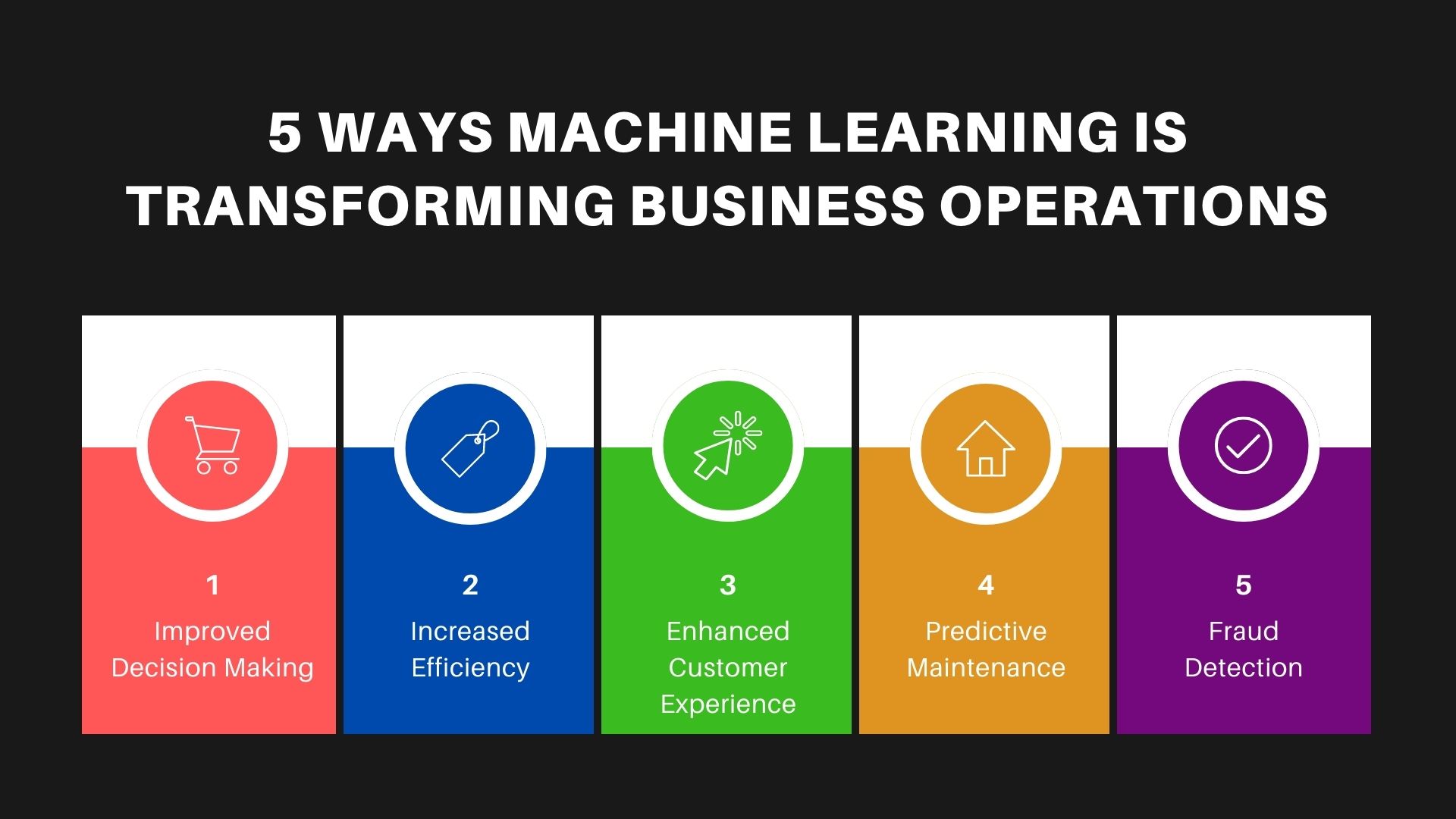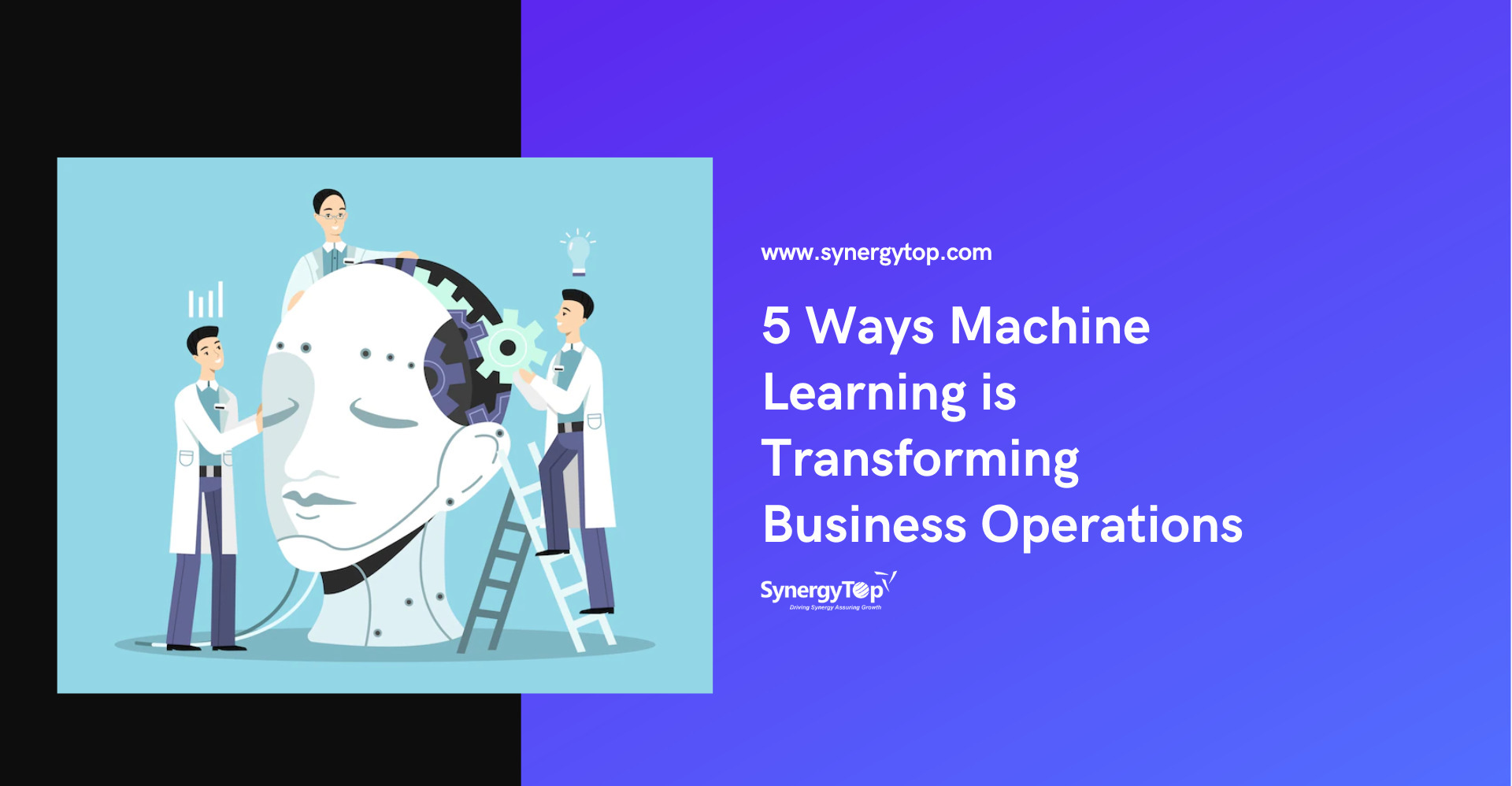Automation of business processes is not a new concept. But with machine learning-driven automation, you can definitely yield unprecedented results for your business.
In fact, that has become more of a necessity now than ever before.
- For one, by 2025, almost all organizations will be using AI/ML in some form for their business and it will become a USD 126 million market.
- And two, with the growing cost of labor, automating mundane tasks is a must.
- It is also important to automate routine tasks to ensure that your workforce can dedicate more time to tasks that really matter.
But how exactly is machine learning changing the way businesses operate in the 21st century?
Well, there are 5 key aspects:

We will be discussing these in greater detail below.
What is Machine Learning?
Before we discuss how machine learning is changing business operations, let us take a look at what it means.
Machine learning is a type of artificial intelligence that involves the use of algorithms and statistical models to enable computers to learn and make decisions without explicit programming. It involves feeding a computer system a large amount of data, which the system uses to make predictions or take actions based on patterns and trends it has identified.
There are several types of machine learning, like
- Supervised learning, in which the system is trained on a labeled dataset, in which the correct output is provided for each example in the training set.
- Unsupervised learning, in which the system is not provided with labeled examples and must find patterns and relationships in the data on its own.
- Semi-supervised learning, which involves a combination of labeled and unlabeled data.
- Reinforcement learning, which involves an agent learning through trial and error as it interacts with its environment.
Machine learning has numerous applications in a wide range of industries, including healthcare, finance, retail, and manufacturing. It is used to solve a variety of problems, such as image and speech recognition, language translation, and fraud detection.
Now there is no limit to how you can leverage machine learning for business operations. But here are the top 5 ways in which implementing machine learning impacts a business’s operations.
5 Ways ML is Changing Business Operations
1. Improved decision making
Proper decision-making is the key to any organization’s success. And machine learning helps key decision-makers fasten and improve the process of taking business decisions.
Machine learning algorithms can analyze large amounts of data and identify patterns and trends that humans may not be able to see. This can help businesses make better, more informed decisions by providing them with insights and recommendations based on data-driven analysis.
Here are a few examples:
- Predictive analytics: A retailer could use machine learning to predict demand for a particular product based on past sales data, allowing them to adjust their inventory levels accordingly.
- Recommendation engines: Machine learning can be used to analyze customer data and provide personalized recommendations based on their preferences and behavior. This can help businesses improve customer satisfaction and increase sales by providing customers with products or services that are tailored to their needs.
- Risk assessment: Machine learning can be used to identify patterns of fraudulent activity, allowing businesses to reduce the risk of fraud and protect their customers’ information. It can also be used to assess the risk of default on loans or other financial instruments, helping financial institutions make more informed lending decisions.
- Optimization: Machine learning algorithms can be used to optimize processes and operations, helping businesses increase efficiency and reduce costs. A manufacturer, for example, could use machine learning to optimize the production process, reduce waste, and increase productivity.
2. Increased efficiency
Machine learning can automate tasks and processes, freeing up time for employees to focus on more complex and value-added work. It can also help businesses streamline their operations and reduce the need for manual labor, thus, increasing efficiency and productivity. For example, a machine learning system could be used to process invoices, freeing up time for employees to focus on more strategic tasks.
ML models can also help streamline day-to-day operations by identifying inefficiencies and suggesting improvements. For example, a machine learning system could analyze data on production processes and suggest ways to reduce waste or improve efficiency.
Further, ML can be used to perform tasks that would otherwise require human labor, reducing the need for manual labor and increasing efficiency. For example, a machine learning system could be used to analyze and classify documents, reducing the need for manual data entry.
3. Enhanced customer experiences
Machine learning can be used to analyze customer data and provide personalized recommendations and experiences. For example, a retailer could use machine learning to recommend products to customers based on their past purchases and browsing history. This can help businesses improve customer satisfaction and increase sales by providing customers with products or services that are tailored to their needs.
Machine learning algorithms can also be used to develop chatbots and virtual assistants that can provide quick and accurate responses to customer inquiries, improving the overall customer experience.
4. Predictive maintenance
Predictive maintenance is a maintenance strategy that involves using data and machine learning algorithms to predict when equipment is likely to fail, allowing businesses to proactively perform maintenance and avoid costly downtime. By analyzing data on equipment performance and maintenance history, machine learning algorithms can identify patterns and trends that can be used to predict when equipment is likely to fail.
There are several benefits to using machine learning for predictive maintenance:
- Reduced downtime: By predicting equipment failures in advance, businesses can perform maintenance before failures occur, reducing the risk of costly downtime.
- Improved asset management: Predictive maintenance can help businesses optimize the use of their equipment, improving asset utilization and extending the life of their equipment.
- Cost savings: By proactively performing maintenance and avoiding costly downtime, businesses can save money on repair and replacement costs.
- Increased safety: Predictive maintenance can help businesses identify potential safety hazards before they become a problem, improving overall safety in the workplace.
Overall, machine learning can be a powerful tool for improving predictive maintenance, helping businesses reduce downtime, improve asset management, save money, and increase safety.
5. Fraud detection
Fraud detection is the process of identifying fraudulent activity in order to prevent it and protect businesses and their customers. Machine learning can be used to identify patterns of fraudulent activity, helping businesses reduce the risk of fraud and protect their customers’ information.
There are several ways in which machine learning can be used for fraud detection:
- Anomaly detection: Machine learning algorithms can analyze data on normal behavior and identify deviations from this behavior that may indicate fraudulent activity.
- Rule-based systems: Machine learning algorithms can be trained to identify specific patterns or rules that are indicative of fraudulent activity.
- Clustering: Machine learning algorithms can group similar transactions together and identify clusters of fraudulent activity.
- Neural networks: Machine learning algorithms based on neural networks can analyze complex patterns in data and identify fraudulent activity.
Overall, machine learning can be a valuable tool for fraud detection, helping businesses reduce the risk of fraud and protect their customers’ information.
Getting Started With Machine Learning For Your Business
The high expected cost of machine learning implementation is one of the key deterrents for businesses. However, with the right ML implementation partner, you don’t have to worry about that.
With an MVP-based product engineering approach, you can make sure you get your businesses powered with machine learning, without disrupting your technology budgets.
Also, with seasoned partners like SynergyTop, you get a wholesome solution. We have a team of experts who can not just understand your ML needs, but also anticipate future roadblocks and thus, help you with a solution that not just works well for the current situation but in the future too.
Further, we offer:
- MVP development in 8 weeks
- 9+ years of successful project delivery record
- 100% quality assurance and bug testing
- Ongoing monthly support
- NDAs signed before project commencement to ensure the safety of your IP assets
- Cross-functional teams with a dedicated project coordinator
You can discuss your machine learning needs with our team of experts by scheduling a free initial call today.
















